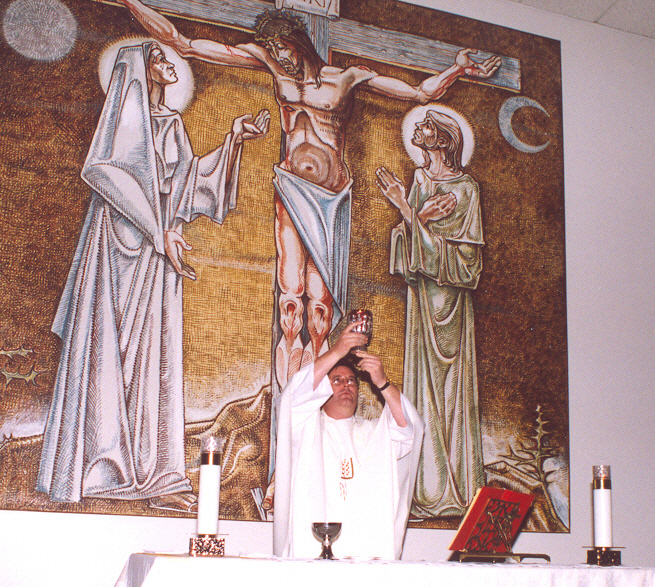
Return to
Index The Catholic Faith
Return to Level
Two Topic Index
Home Page
The Liturgy of the Eucharist begins with the Preparation of the Gifts. Bread, wine, and water are brought up to the priest from the people. The priest accepts them, placed them on the altar, and with special prayers offers them to God.
All of the words and actions are rich with meaning. Whenever God wants to do something for us, he always does it in a way that helps our understanding; he uses a sign on one level that shows us what is happening on a higher level.
The bread and wine brought forward from the people will soon become the Body and Blood of Jesus. The bread is made up of many grains of wheat and the wine of many grapes, just as the people, though many, are made into the one Body of Christ through the mysteries of the Eucharist. We, though many, share the one bread and are made one.
At this time in the Mass we should be offering ourselves to God: our whole selves, including our joys and sorrows. A hymn may be sung that can help us understand the actions and the signs. The Prayers over the Gifts acknowledge God's goodness as Lord of all creation and the goodness of creation itself. They ask God's blessing on these gifts which are to become for us the bread of life and our spiritual drink. After the priest offers the bread, and again after he offers the wine, the people respond, "Blessed be God forever."
The Washing of the Hands of the priest signifies the great purity with which we should approach the Eucharist. It is a prayer to God to wash away our sins as we come close to him. The priest then invites the people to pray that our sacrifice may be accepted by God, the Almighty Father.
The people respond with a prayer that our sacrifice may be accepted at the hands of the priest for three purposes: 1. the praise and glory of God's name; 2. for our benefit; and 3. the good of all the Church. This prayer can remind us that in all that we do, God's glory must be considered first; our good and the good of all the Church, though very important, come second. With his hands extended, the priest then says a prayer that the gifts will be acceptable and pleasing to God. The people stand for this prayer and give consent to it by saying, "Amen".
The Eucharistic Prayer

Now comes the high point of the Mass, called the EUCHARISTIC PRAYER or CANON. It is this part of the Mass that bread and wine become the Body and Blood of Our Lord and the sacrifice is offered to God. The prayer begins with the Preface, a consideration of the coming sacrifice in light of the liturgical season of the year or of a feast day. It ends as we join our voices to those of the angels in Heaven in the hymn called the Sanctus: "Holy, holy, holy Lord, God of power and might: Heaven and earth are full of your glory. Hosanna in the highest. Blessed is he who comes in the name of the Lord. Hosanna in the highest."
The word "hosanna" (a Hebrew word meaning "save us") is a special exclamation of joy in the salvation God has promised to us. It expresses our joyful expectation of God coming to us as our salvation. The people, who were standing to give praise, now kneel and remain kneeling for the most solemn part of the Mass.
The priest extends his hands over the gifts and invokes the Holy Spirit, asking him to come upon them and make them holy so that they may become the Body and Blood of Our Lord Jesus Christ. Then he continues with the Consecration, in which he says: "This is my Body . . . this is the cup of my Blood."
The priest holds up the consecrated Host and then the chalice with the Precious Blood; as he holds them up for the people to adore, he and the people offer the Holy Sacrifice, Christ's Body and Blood, to our Heavenly Father. This is the part of the Mass where we are called on to proclaim our belief in this great mystery of our faith - that Jesus really is present on the altar now.
The Canon also contains prayers for the Church, for the living, and for the dead. Then the priest takes the chalice and the paten with the Host and, lifting them up, says: "Through him, with him, in him, in the unity of the Holy Spirit, all glory and honor is yours, Almighty Father, forever and ever."
This prayer is called a Doxology. The people respond with "Amen", which means that they fully assent to the prayer of the priest, and the sacrifice is complete.
"This first of all I ask,
that petition, prayer, entreaty, and thanksgiving
should be offered for all mankind." (1 Timothy 2:1)
Used with the permission of The Ignatius Press 800-799-5534
Return to
Index The Catholic Faith
Return to Level
Two Topic Index
Top
Home Page